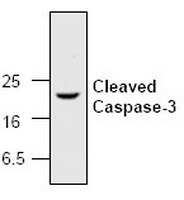PC679 Sigma-AldrichAnti-Caspase-3, Cleaved (Ab-2) Rabbit pAb
Anti-Caspase-3, Cleaved (Ab-2), rabbit polyclonal, recognizes the ~17 kDa cleaved fragment of caspase-3. It is validated for WB, ICC, and IHC in frozen and paraffin sections.
More>> Anti-Caspase-3, Cleaved (Ab-2), rabbit polyclonal, recognizes the ~17 kDa cleaved fragment of caspase-3. It is validated for WB, ICC, and IHC in frozen and paraffin sections. Less<<Synonyms: Anti-Active Caspase-3
Recommended Products
Áttekintés
| Replacement Information |
|---|
Kulcsspecifikációk táblázata
| Species Reactivity | Host | Antibody Type |
|---|---|---|
| H, M, R | Rb | Polyclonal Antibody |
| References |
|---|
| Product Information | |
|---|---|
| Form | Liquid |
| Formulation | In PBS, pH 7.2, 30% glycerol, 0.5% BSA, 5 mM EDTA. |
| Positive control | A-431 cells treated with an inducer of apoptosis |
| Preservative | 0.03% Proclin |
| Quality Level | MQ100 |
| Physicochemical Information |
|---|
| Dimensions |
|---|
| Materials Information |
|---|
| Toxicological Information |
|---|
| Safety Information according to GHS |
|---|
| Safety Information |
|---|
| Product Usage Statements |
|---|
| Packaging Information |
|---|
| Transport Information |
|---|
| Supplemental Information |
|---|
| Specifications |
|---|
| Global Trade Item Number | |
|---|---|
| Katalógusszám | GTIN |
| PC679 | 0 |
Documentation
Anti-Caspase-3, Cleaved (Ab-2) Rabbit pAb Certificates of Analysis
| Title | Lot Number |
|---|---|
| PC679 |
Brochure
| Title |
|---|
| Caspases and other Apoptosis Related Tools Brochure |








